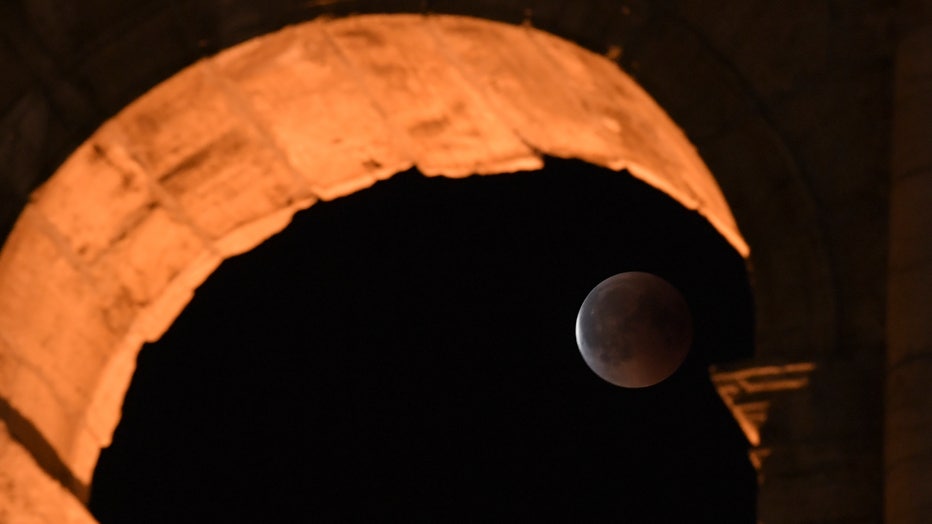Eclipses of the past were calamitous, not celebratory
Anatomy of a solar eclipse
FOX 4's Dan Henry breaks down what exactly will happen during the total solar eclipse on April 8. (Video courtesy of FOX 4 Dallas)
As anticipation mounts for the total solar eclipse on April 8, many Americans may not realize that ancient civilizations didn't regard such events as captivating celestial spectacles but rather as ominous signs of impending catastrophe.
By meticulously studying ancient texts and artifacts, including the Babylonian tablets from Mesopotamia, hieroglyphic inscriptions from Egypt and many other historical records, scholars have unraveled the beliefs and rituals surrounding eclipses in antiquity.
Here is a look into what ancient cultures thought of a solar eclipse:
Mesopotamia
In ancient Mesopotamia, eclipses were perceived as harbingers of impending calamity. Priests carefully documented these celestial occurrences, believing they carried cosmic significance and necessitated rituals to avert disaster.
The Babylonian Chronicles, ancient clay tablets chronicling significant events in Mesopotamia, notably record an eclipse in 763 BCE.
This event aligns with a passage in the Book of Amos (8:9), where a prophet vividly describes a chilling vision of the sun vanishing at noon, likely referencing the same occurrence. This correlation offers valuable historical insight into the cultural significance of celestial phenomena in ancient Mesopotamia and Israel.
In this section of the Bible, where the prophet Amos denounces social injustices among the wealthy elite, scholars attribute the referenced eclipse to a period of political upheaval during the reign of King Ashur-Dan III in Assyria.

FILE - This picture shows the full moon during a blood moon eclipse behind the ancient Colosseum on July 28, 2018 in Rome. (Photo by TIZIANA FABI/AFP via Getty Images)
Egypt
Likewise, in ancient Egypt, eclipses were deeply entwined with religious narratives. Scholars suggest that ancient inscriptions depicting the sun god Ra locked in celestial combat with the serpent Apep may actually allegorize a solar eclipse.
It is believed that the ancient Egyptians perceived these celestial occurrences as symbolic representations of the eternal conflict between light and darkness, imbuing eclipses with profound theological significance.
Mesoamerica
The Maya civilization of Mesoamerica, celebrated for its profound comprehension of astronomy, perceived eclipses as ominous portents of destruction. Within the hallowed pages of the Dresden Codex, one of the few surviving historical texts spared from the annihilation wrought by Spanish conquistadores, a striking image emerges: two eclipses set against the backdrop of a tumultuous sky and a raging flood.

Rites of ancient Peruvians during a Solar Eclipse, engraving by Lasinio, from Raccolta di Viaggi (Travel Collection), by Francesco Costantino Marmocchi, Tome X, published by Fratelli Giachetti, Prato, 1840-1847. (Photo by Icas94 / De Agostini Picture
In Mayan cosmology, floods held profound significance, often intertwined with narratives of cataclysmic events heralding the end of the world.
According to Space.com, the Aztecs perceived solar eclipses as unpredictable occurrences, each event prompting unique interpretations. In one pictograph capturing an eclipse, a jaguar—a symbol of darkness—can be seen engulfing the sun, indicative of their belief system. To ward off this cosmic predator, Aztec people engaged in vocal rituals, shouting and screaming to drive away the symbolic jaguar and restore the sun's brilliance.
Greece
For ancient Greeks, eclipses were an act of abandonment by the gods. The word "eclipse" comes from the Latin word "eclipsis," which is derived from the Greek "ekleipsis," which actually means "abandonment" or "a forsaking," according to Merriam-Webster.
Upon witnessing a solar eclipse in 647 B.C., the poet Archilochus penned the following words: "There is nothing beyond hope, nothing that can be sworn impossible, nothing wonderful, since Zeus, father of the Olympians, made night from mid-day, hiding the light of the shining Sun, and sore fear came upon men."
The 2024 solar eclipse path
Capturing the sounds of a solar eclipse
A NASA-sponsored study is enlisting citizen scientists to record their sounds and sites of the total solar eclipse in April to better understand how wildlife is response to the eclipse. (Video: NASA)
The April 2024 solar eclipse will be visible, at least in part, to nearly everyone in the U.S. But the path of totality – where the moon will completely block the sun – is a 115-mile-wide region that stretches from southern Texas up through Ohio, then over to northern Maine.
Large cities in the path of totality include:
- Austin, Texas
- Dallas, Texas
- Little Rock, Arkansas
- Carbondale, Illinois
- Indianapolis, Indiana
- Cleveland, Ohio
- Buffalo, New York
- Plattsburgh, New York
- Presque Isle, Maine
The farther you are from that path, less and less of the sun will appear to be blocked.
What time is the solar eclipse?
Southern Texas will see the peak of totality first, around 1:30 p.m. Central Daylight Time. Then Dallas at 1:42 p.m., with the time getting later and later as the moon’s shadow moves north. Indianapolis will see the peak around 3:05 p.m. Eastern Daylight Time; Cleveland at 3:15 p.m., and northern Maine around 3:30 p.m.
RELATED: Cities have been eclipse-planning for months, ready to capitalize on tourism boom
However, it will take several hours for the moon to move across the sun, so the actual eclipse event will start just over an hour before the peak of totality, with more and more of the sun slowly being blocked.
How long is the solar eclipse?
Eye protection for April's total solar eclipse
If you’re among the millions of people who will get the chance to witness April’s total solar eclipse, you’re going to want to use eye protection. Vitreoretinal surgeon at New York Eye and Ear Infirmary of Mount Sinai Dr. Avnish Deobhakta joined FOX Weather on Sunday to explain the dangers of viewing the eclipse without proper eye protection.
Again, that depends on where you are. Those closest to the center of the path will see total darkness for about four minutes at the peak of totality.
RELATED: 105-year-old eclipse buff excited to see his 13th eclipse on April 8
But because the moon moves slowly across the sun’s path, the entire eclipse event – from when the moon first clips the sun until the time it clears – will last from 90 minutes to over two hours for those in the path of totality.
Where do I look for the solar eclipse?
The easiest way to know may be to step outside in the days leading up to the eclipse and see where the sun is during the afternoon.
MORE: How to get the best view of the solar eclipse
Early afternoon on April 8, the sun will be pretty high in the sky. As always, though, the further north you are, the lower in the sky the sun will appear.
Astronaut's perspective on the solar eclipse
Would you rather see an eclipse from space or from here on Earth? In this interview facilitated by Sonic, here’s the perspective of Col. Terry Virts, one of the few human beings who has done both.
For example, in Austin, the sun will be at 67 degrees up from the horizon at the peak of totality. Remember, 90 degrees is straight up, so 67 degrees is just over two-thirds up into the sky from the horizon.
In Cleveland, meanwhile, the sun will be slightly lower, at only 49 degrees – just over halfway up in the sky.
When is the next total solar eclipse?
After 2024, NASA says, the next total solar eclipse visible from any point in the contiguous United States will occur in 2044. Totality will only be visible from North Dakota and Montana.
RELATED: Look out for comet, planets during the total solar eclipse
The next total solar eclipse that will travel across the lower 48 states from coast to coast is in 2045.

